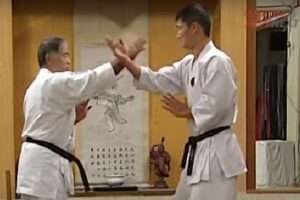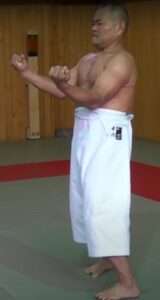First of all, let’s understand the translation of Muchimi. It comes from the word “mochi” (餅), which means (sticky) rice cake. In standard Japanese, it is pronounced “mochimi,” while in Okinawan, it is pronounced, “muchimi.”
Imagine sticky rice that can be pounded into a thick paste—it’s dense and clings to everything it touches. In karate, muchimi refers to developing a similar concept in your movements.

To develop muchimi, there’s a training called Kakie (Pushing hands). During Kakie, you have constant contact with a partner, which helps you feel and understand their movements through touch. It’s like having a unique sense through physical contact. You can feel if someone is relaxed or tense, balanced or unsteady. You learn to sense their intentions just by touching them. Kakie can be practiced while standing still or moving around (Suri-ashi).

Kata, such as Sanchin and Tensho, also play a role in developing muchimi. These kata involve slow and deliberate movements that make you feel inward and become aware of your body’s posture. By tensing your muscles and maintaining physical contact within the kata, you develop your internal strength and become more aware of how your body moves.
By combining these training methods, muchimi becomes a part of your karate skills. You learn to move with a “sticky and heavy feeling”, and you develop a deep understanding of your own body and how to stay connected in your movements.
Different styles and schools of karate may interpret and apply muchimi in varying ways. Its development and expression depend on the instructor’s teachings, lineage, and individual interpretation.
However, there are several factors that are connected to the interpretation of muchimi in karate context, those are:
Body Alignment: Proper alignment of the spine, joints, and muscles is crucial for generating and absorbing force efficiently while maintaining a relaxed yet firm posture.
Relaxation and Tension: Balancing overall relaxation with appropriate muscle tension enables the practitioner to generate power and stability at key moments.
Connection and Flow: Muchimi involves maintaining a harmonious connection between various body parts, facilitating efficient energy transfer and power generation.
Sensitivity and Timing: Developing sensitivity to an opponent’s movements and timing allows for appropriate responses, including redirection, counterattacks, and maintaining control.
Overall, muchimi is a dynamic concept that enhances karate techniques by promoting effective movement, sensitivity, and adaptability in combat or self-defense scenarios.
Thanks for reading.
Gert
